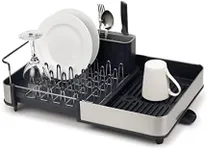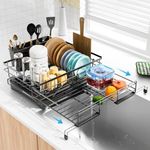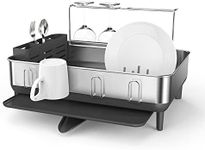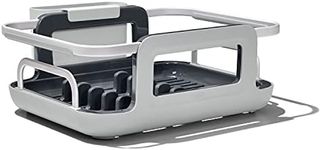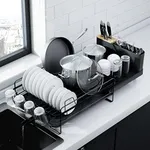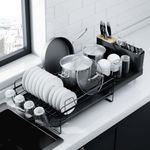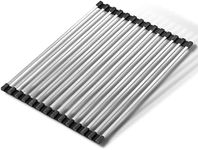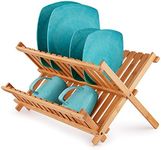Buying Guide for the Best Dish Racks
Choosing the right dish rack can make your kitchen more organized and your dish-drying process more efficient. When selecting a dish rack, consider the size of your kitchen, the number of dishes you typically wash, and the material and design of the rack. A good dish rack should be durable, easy to clean, and have enough space to accommodate your dishes, glasses, and utensils. Here are some key specifications to consider when choosing a dish rack.Size and CapacityThe size and capacity of a dish rack determine how many dishes it can hold at once. This is important because you want a dish rack that can accommodate your typical load of dishes without being too bulky for your kitchen space. Small dish racks are suitable for individuals or small households with limited counter space, while medium-sized racks are ideal for average-sized families. Large dish racks are best for bigger families or those who entertain frequently and need to dry a lot of dishes at once. Consider your kitchen counter space and the number of dishes you usually wash to choose the right size and capacity.
MaterialDish racks come in various materials, including plastic, stainless steel, and bamboo. The material affects the durability, weight, and aesthetic of the dish rack. Plastic dish racks are lightweight, affordable, and easy to clean, but they may not be as durable as other materials. Stainless steel dish racks are sturdy, rust-resistant, and have a sleek look, making them a good choice for modern kitchens. Bamboo dish racks are eco-friendly and have a natural appearance, but they require more maintenance to prevent mold and mildew. Choose a material that fits your kitchen decor and meets your durability needs.
Design and LayoutThe design and layout of a dish rack determine how efficiently it can hold and dry your dishes. This is important because a well-designed dish rack can save you time and effort. Some dish racks have multiple tiers, which provide more drying space without taking up extra counter space. Others have specific compartments for utensils, glasses, and plates, which help keep everything organized. Look for a design that suits your dish-drying habits and fits well in your kitchen. If you have a lot of different types of dishes, a dish rack with various compartments and tiers might be the best choice.
Drainage SystemA good drainage system ensures that water from the drying dishes flows away efficiently, preventing water from pooling and causing mold or mildew. This is important for maintaining a clean and hygienic kitchen. Some dish racks come with a built-in drainage tray that collects water and directs it into the sink, while others have a spout that channels water directly into the sink. Consider how the dish rack will be positioned on your counter and choose a drainage system that works best for your setup. If you have limited counter space, a dish rack with a built-in drainage tray might be more convenient.
Ease of CleaningEase of cleaning is an important factor because a dish rack that is difficult to clean can harbor bacteria and mold. This is important for maintaining a hygienic kitchen environment. Look for dish racks with removable parts that can be easily washed and dried. Materials like stainless steel and plastic are generally easier to clean than bamboo. Consider how often you are willing to clean the dish rack and choose one that fits your maintenance preferences. If you prefer low-maintenance options, a simple design with fewer parts might be the best choice.

